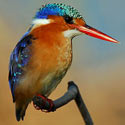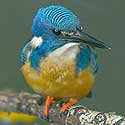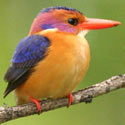|
Family: Alcedinidae (alcedinid
kingfishers)
Life
> Eukaryotes >
Opisthokonta
> Metazoa (animals) >
Bilateria >
Deuterostomia > Chordata >
Craniata > Vertebrata (vertebrates) > Gnathostomata (jawed
vertebrates) > Teleostomi (teleost fish) > Osteichthyes (bony fish) > Class:
Sarcopterygii (lobe-finned
fish) > Stegocephalia (terrestrial
vertebrates) > Tetrapoda
(four-legged vertebrates) > Reptiliomorpha > Amniota >
Reptilia (reptiles) >
Romeriida > Diapsida > Archosauromorpha > Archosauria >
Dinosauria
(dinosaurs) > Saurischia > Theropoda (bipedal predatory dinosaurs) >
Coelurosauria > Maniraptora >Aves (birds) > Order: Coraciiformes
Species indigenous to southern Africa
|
Alcedo
cristata (Malachite kingfisher) The
Malachite kingfisher is common in many areas of southern Africa, living in a
wide variety of aquatic habitats. It feeds mainly on fish, as well as
amphibians and insects. Both sexes dig a burrow, which is used as a nesting
site, and placed in the banks of rivers or streams. It lays 3-6 eggs, which
are incubated by both sexes, for 14-16 days. The chicks are brooded for the
first few weeks of their lives, before leaving the nest at 22-25 days old.
They start fishing within one week of fledging, sometimes "catching" twigs
and leaves. They are chased away by their parents at 36-41 days old. |
 |
|
Alcedo
semitorquata (Half-collared kingfisher)
The Half-collared kingfisher is widespread but uncommon, with populations
scattered across sub-Saharan Africa. In southern Africa, it is most common
in Zimbabwe and South Africa's rivers, streams and estuaries. Its diet
consists mostly of fish, which it hunts by sitting on a perch for long
periods then, once it spots a fish, diving in to catch it. It nests in
burrows dug into vertical riverbanks, excavated by both sexes. Here it lays
1-6, usually 3-4 eggs which are incubated by both sexes. The chicks probably
remain in the nest for about 27 days, learning to fly soon after emerging. |
 |
|
Ispidina
picta (African pygmy-kingfisher, Pygmy kingfisher)
The African pygmy-kingfisher is widespread across sub-Saharan Africa, partly
due to its ability to live in a wide range of woodland types. Unlike many
other Alcedinid kingfishers, the African pygmy-kingfisher rarely eats fish,
but rather feeds mainly insects, occasionally small vertebrates. It is an
intra-African breeding migrant, arriving here in September-October. Soon
afterwards, it starts breeding, laying 3-6 eggs in a burrow dug into a
sandbank. The chicks stay in the nest for a 2-3 weeks, after which they
rapidly develop hunting skills, becoming fully independent soon after
fledging. Then, the juveniles and adults migrate back to other parts of
Africa. |
 |
|
